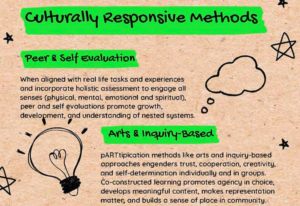Universal Design and Assessment: How it Works
- 3 mins read
Download an alternate text format
Reference
A Comprehensive Guide to Applying Universal Design for Learning | A Collection of Three UDL Workbooks.
You should read this entire series. It goes into considerable depth regarding the need to change our thinking about instructional design and teaching to become more inclusive and accessible. This includes assessment design. But if you truly you only have a moment, consider the following summary of the third book in the series, which is a discussion on how to apply Universal Design Principles (UDL) to assessment design. Here are a few highlights.

Diversify Assessments
To begin, we should recognize the limitations inherent in traditional assessments, such as timed exams and essays. While exams often prioritize rote memorization, essays might not fully engage students in deep synthesis if the focus shifts to mechanics over critical thinking. We encourage you to explore a spectrum of assessments, each offering unique advantages and challenges. Your role is to find a balance that supports learning in its various forms, from memorization to critical analysis and skill-building. By diversifying assessment methods, you can make your courses more accessible and engaging, ensuring that all students can demonstrate their learning effectively.
Institutional Constraints with UDL Principles
Often, personal teaching philosophies clash with institutional requirements or accreditation standards, particularly around assessment methods. However, UDL can help with a reconceptualization of assessment designs that align with student learning outcomes, leveraging its principles to overcome these constraints.
UDL-Informed Assessment Strategies
Adopting a UDL approach requires a shift in perspective: think of assessments not as endpoints but as ongoing check-ins that guide the expansion of student knowledge. This entails:
- Prioritizing clarity in learning outcomes and objectives to align assessments meaningfully with course goals.
- Balancing high-stake and low-stake assessments to encourage continuous engagement and learning.
- Managing workloads thoughtfully to ensure assessments are meaningful and doable.
- Utilizing feedback and rubrics to provide clear, actionable insights into student performance.
Innovative Assessment Methods
Consider integrating innovative assessment methods, such as multimedia projects, e-portfolios, and collaborative assessments. These approaches not only cater to diverse learning preferences but also mirror real-world tasks, enhancing the relevance and applicability of learning experiences.
Through examples, this guide illustrates how each method can be adapted to fit UDL principles, offering flexibility, choice, and opportunities for student engagement in the assessment process.
Reflecting on and Refining Assessment Practices
We really only improve as professional educators with ongoing reflection and revision of our practices. In this way, our growth as educators never ceases. It is important to consider how assessments can be redesigned to better support all students, suggesting a thoughtful examination of barriers and potential UDL-informed solutions. Engage with students in this process to ensure assessments are relevant, challenging, and aligned with their learning goals.
If you take a deep dive into UDL, you commit to an educational practice that values diversity, inclusivity, and meaningful learning. Implementing UDL in assessment design enriches the learning experience for students and overall adds depth to your repertoire as an instructor.
Reference
A Comprehensive Guide to Applying Universal Design for Learning | A Collection of Three UDL Workbooks.








